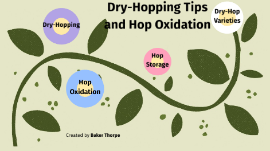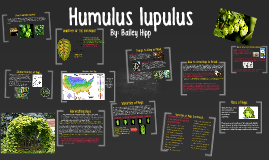HOPS
Transcript: Uses of Hops These are some of the different cone shapes of the Hop plant. This is a cross cut section of a halleurteur cone. (4.) Plant the rhizome horizontally about 1-inch below the surface of the soil. Rhizomes can also be planted vertically, with the buds pointing up. Crystal Hops should be harvested before the first frost. The actual date will vary depending on your location, but mid-August to mid-September is most common. Hops are ready to harvest when the aroma is strongest. Test the aroma by smelling a crushed hop cone. As you squeeze a mature hop between your fingers, you should notice a yellow powder from the lupulin glands. **Ripe cones will feel dry and papery. With some varieties the color will be lighter. Slight browning of the lower bracts of the cone is normal, and a good sign of maturity. **Keep rhizome refrigerated until soil is ready for planting. Do not let the rhizome get completely dry, but also do not keep them too wet. To keep rhizome moist simply mist it regularly. (1.) When soil is workable, you can plant the rhizome in the ground. So long as the ground does not freeze then the hop plant can survive the frost. These are the structures inside the hop flower that support and give it the structure that it has. KEEP WATCH FOR PESTS: In praticular watch for downy mildew disease for some varieties of Hops. This disease usually appears as stunted, deformed new shoots in early spring, soon with black fuzz on the undersides of leaves. Simply cut the new shoots off. Organic Copper sprays may help. Also watch for aphids and small mites under leaves. Both can be controlled by chemical sprays. Varieties of Hops Continued... Leaves are usually oval- cordate, ranging in sizes of small to medium. They also have a rough texture and coarse serration along the margins. Also yellow green on top part of leaf and whitish green below. Stem can be light green to tan and sometimes smooth to prickly. The Hop's plant is dioecious; with male staminate and female pistillate plants. ** Store hops away from oxygen. Most home growers don’t have access to oxygen-barrier bags and vacuum sealers, so the best compromise is to pack as many hops as possible into a ziplock-style freezer bag. Squeeze them tight to remove as much air as possible and seal the bag. Store hops frozen until used. PLANTING HOPS REQUIRES PLANTING THE HOP RHIZOME. THE HOP RHIZOME IS THE CUTTING OF THE FEMALE, CONE-PRODUCING HOP PLANT. HOPS CAN BE PLANTED JUST ABOUT ANYWHERE IN THE UNITED STATES. AND THEY REQUIRE A TOTAL OF 10 FROST FREE DAYS IN ORDER TO PRODUCE FULL RIPE FLOWERS. UNDER GOOD CONDITIONS, YOU CAN YIELD UP TO TWO POUNDS OF HOPS PER VINE. BULLION - A bittering hop with an American aroma CASCADE - Unique floral character, defines pale ale CENTENNIAL - Higher alpha acid than Cascade CHINOOK - High alpha with resiny grapefruit aroma CLUSTER - Original American hop with a ‘cattiness” COLUMBUS - Highly productive, super high-alpha variety CRYSTAL - Fine Hallertauer character, Ultra clean EROICA - Pungent English flavor for generalbittering FUGGLE - Traditional hop for darker beer GALENA - Pungent English flavor HALLERTAUER - Traditional superior aroma hop Lower the hop vine to the ground to begin the harvest. Pick only the cones, not the leaf material. Dry hops before usage or storage. In dry weather, airdrying is preferable. Spread them shallowly onto a window screen, and keep them out of direct sunlight. Every day you should “fluff” the hops to bring moist hops to the outside of the pile. The hops are dry when the inner stem of the hops is brittle. It should break rather than bend. **If you must dry hops with a food dehydrator or in the oven, keep the temperatures under 140 degrees. Hop leaves and what makes up the outer structure of the hop flower. They are used primarily as a flavoring and stability agent in beer, to which they impart bitter, zesty, or citric flavours; though they are also used for various purposes in other beverages and herbal medicine. How to Grow Hops In Detail... It is a perennial vine growing up to 19 ft and higher. It's bloom color is greenish/yellow. Things to Keep in Mind.. (2.) Make sure the area the hops plant will be in gets plenty of sunlight. Hops thrive in light textured, well drained soil with a pH of 6.0-8.0. If drainage is a problem, you may build mounds using the surrounding topsoil mixed with organic matter. Urban growers should ensure the hops are not in the immediate vicinity of a strong 24-hour light source, as this will prevent flowering. Hardiness Zone Map Humulus Iupulus How to Grow Hops in Detail Continued... CHOOSE A GOOD SITE BEFORE PLANTING: Hops tolerate a sandy or dry soil, If you provide plenty of water; and clay soil IF it is well-drained. Make sure your topsoil is deep enough for the massive root systems. Test your soil for fertility as you would a vegetable or perennial garden. Typically hops that are homegrown are used for aroma more than anything. By: Bailey Hipp Humulus Iupulus

















